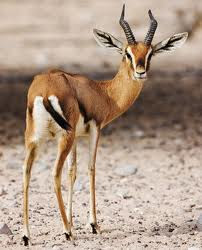True Wild Life | Arabian Gazelle | The Arabian gazelle, or mountain gazelle has a wide range throughout the Middle East, but is listed and protected in the Arabian Peninsula, Palestine, and Sinai. This species has a slender build with a proportionally long neck and long hind legs. It has a dark brown coat, white underparts and a black, short, and bushy tail. Both male and female gazelles have horns and their ears are relatively short. Adults weigh up to 51 lbs on average and females are smaller than males. Arabian gazelles are excellent runners and can reach speeds of 80 km per hour. They have excellent vision, hearing, and a good sense of smell to help detect predators and to find food.
The Arabian gazelle prefers mountainous and hilly habitat consisting of light forests, fields, or desert plateaus. Days are usually spent in the hills and at night or in the early morning they come down to forage. They prefer to eat grasses, herbs, and shrubs but can eat other varieties of food, depending on what is available in their habitat. Groups consist of three to eight gazelles, and males are territorial preferring one or more females in the group and their young. Mating occurs mainly in the early winter, but can take place year-round if food is not scarce. The female gives birth to only one calf after a gestation period of 180 days. Males may leave after about six months, but females may remain with their mother for life.
The main threats to the species is habitat loss. Also hunting and collecting, trade, alien invasive species, and hybridizers threaten the Arabian gazelle population. Strict laws are currently in place and have helped to prevent poaching of the species, but habitat loss and exploitation continue to be a threat.



No comments:
Post a Comment